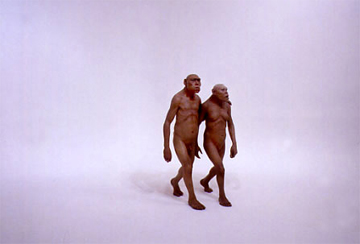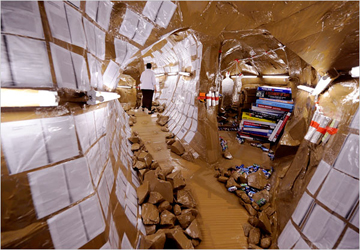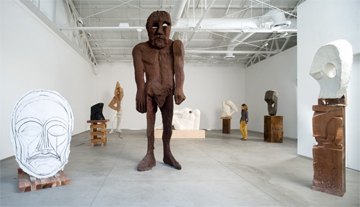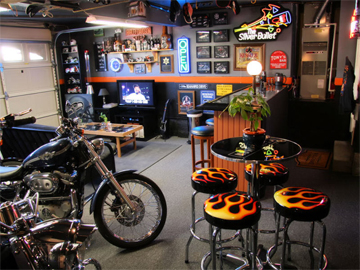[youtube:https://www.youtube.com/watch?v=Bnd8TV2mn08]
This backflip stands out among the many iconic scenes of the seminal 1992 film, Encino Man, for its purposefully calibrated relationship to time and space, history and gravity. (Full disclosure: I grew up in Encino, California and yes, I am a Man; we’ll get to Encino Woman in a bit.) While it is surely important to note that the conventions of film editing have the potential to effect a form of time travel themselves, as they can span great distances in time (see what is perhaps the most famous graphic match cut in film history: a falling bone flung skyward by early man “becomes” a futuristic spacecraft through the magic of editing in the opening sequence of 2001: A Space Odyssey — a cut that is directly referenced in the opening earthquake sequence of Encino Man), space often comes to figure time, as in the hallucinatory fall that foretells the temporal undoing of the main characters of Vertigo, not to mention my own recourse to measuring time in “distances” earlier. What then do we make of Link’s backflip, the first thing this ice age caveman manages to do right after being excavated in a suburban backyard and stepping on a rake, mistaking a garbage truck for a mastodon, walking into glass, etc.? What can this prehistoric body gracefully falling through space tell us about time?
Art always unfolds in the present. It is historical insofar as it releases other times into our own. Regardless of how ancient it is, it, more often than not, tells us more about ourselves than it gives us an accurate picture of life at the time of its making. Perhaps that is what is so compelling about the cave paintings at Lascaux. Like the backflip that announces Link’s arrival at high school, the figure of the erect, bird-masked shaman falling through the sky seems to say, “I am here.” Not, “I was here,” but “I am here.”
It is the presentness of the past in even the most novel contemporary forms that I seek to address in this monthly column for Art21. While I will not limit myself to the excavation of prehistoric forms, I will be digging the contemporary visual landscape for lingering intensities from yesterday and decades, centuries, millennia ago. One way I will do this will be to mine contemporary art, film, and museum practices for wonderful and perverse histories. Another will be to dig into my own ever-expanding collection of VHS videotapes, which I regularly acquire from the many thrift stores here in Los Angeles. These cast-offs from a not-too-distant era of cinematic consumption, embedded as YouTube videos in the column, will allow us to hold the present in material relation to an eclipsed technology that haunts our second-hand stores, if not our notions of technological advancement.

Tim Noble and Sue Webster, "The New Barbarians," 1997-1999. Fiberglass and translucent resin. Courtesy Modern Art, London.
It would reflect unspeakable hubris on our part if we were to say that fire was the Internet of the ice age. If we were playing pancakes or waffles, I would take fire in a hot second. And yet, here you are, your face and hands pressed close to the glow of your monitor and keyboard. In the context of the contemporary artist’s negotiation with the caveman, however, it is not so much a question of the fire, but how close he or she gets to identifying with it and the cavemanness of the caveman, if you will. Take Tim Noble and Sue Webster’s The New Barbarians. It’s not that dissimilar to the ending of Encino Man, when Link’s unfrozen ice age girlfriend crashes the pool party, except here, the caveman and cavewoman are the artists themselves, perhaps striding into a Michael Asher opening. While they are framed by the white cyclorama of an Apple product photography shoot, their faces evince the quiet attitude of philosophers pondering the materiality of fire and not how to, let’s say, burn a frog. The equal partnership between caveman and cavewoman in Noble and Webster’s work is not, however, reflected in the quality of the made-for-TV sequel to Encino Man, Encino Woman.
While Thomas Hirschhorn’s Cavemanman installation is made out of completely modern materials, such as cardboard and packing tape (like Noble and Webster’s work), it places the visitor inside the cave and the caveman inside us. This gets closer to the Encino Man sensibility of freely collapsing distinctions between us and them, allowing cross-identifications. However, while Encino Man sublimates this collapse into assimilation and joy, Cavemanman attempts to extract an anxiety around extinction, albeit through a comic form. The tension resolves itself in parody and the violent immanence of the caveman is kept at bay.
Thomas Houseago’s sculptures are the latest, and perhaps the least explicit contemporary artworks to engage the vogue of the caveman. Houseago contends that his work extends modernism’s engagement with “the primitive.” I would argue, however, that even if we put aside the recent trend of reviving insufferable overdeterminations of primitivity, rather than looking like a Picasso looking at a fetish or a mask, Houseago’s work looks like it was made by a caveman with some dim notion of Picasso’s oeuvre. And that, in effect, makes it a form of sculpture completely compatible with our time; the time not of the “caveman,” but the time of the “man cave,” the dark basement refuge of the self-emasculated bourgeois American consumer who buys his ticket back to manhood (on evenings and weekends) with the purchase of a bigger and better flatscreen TV every year and who, incidently, also has some dim notion of Picasso’s oeuvre.
When man is anxious about time, he looks to fire (note the flaming stools). When he knows his time has nearly come to an end, he retreats to the cave. He knows. He knows…
[youtube:https://www.youtube.com/watch?v=_rdmwG5CMEE]
Karthik Pandian’s “Art in the Twenty-First Century BC” column publishes once a month on the second Thursday.







